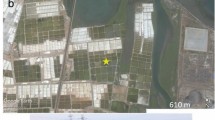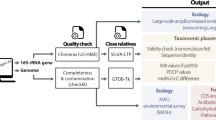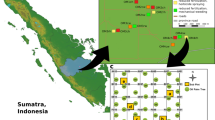Abstract
Small subunit (16S) rRNA gene surveys generating near full-length 16S rRNA clones offer a unique opportunity for in-depth phylogenetic analysis to highlight the breadth of diversity within various major bacterial phyla encountered in soil. This study offers a detailed phylogenetic analysis of the Proteobacteria-affiliated clones identified from 13 001 nearly full-length 16S rRNA gene clones derived from Oklahoma tall-grass prairie soil. Proteobacteria was the most abundant phylum in the community, and comprised 25% of the total clones. The most abundant and diverse class within the Proteobacteria was Alphaproteobacteria, followed by the Delta-, Beta- and Gammaproteobacteria. Members of the Epsilon- and Zetaproteobacteria were not detected in the dataset. Our analysis identified 15 novel order-level and 48 novel family-level Proteobacteria lineages. In addition, we show that the majority of Proteobacteria clones in the dataset belong to orders and families containing no described cultivated representatives (50% and 65%, respectively). An examination of the ecological distribution of the six most abundant Proteobacteria lineages in this dataset with no characterized pure culture representatives provided important information regarding their global distribution and environmental preferences. This level of novel phylogenetic diversity indicates that our understanding of the functions of soil microorganisms, even those belonging to phyla with numerous and diverse well-characterized cultured representatives such as the Proteobacteria, remains far from adequate.
Similar content being viewed by others
Log in or create a free account to read this content
Gain free access to this article, as well as selected content from this journal and more on nature.com
or
Accession codes
References
Ashelford KE, Chuzhanova NA, Fry JC, Jones AJ, Weightman AJ . (2005). At least 1 in 20 16S rRNA sequence records currently held in public repositories is estimated to contain substantial anomalies. Appl Environ Microbiol 71: 7724–7736.
Cole JR, Chai B, Farris RJ, Wang Q, Kulam SA, McGarrell DM et al. (2005). The Ribosomal Database Project (RDP-II): sequences and tools for high-throughput rRNA analysis. Nucleic Acids Res 33: D294–D296.
DeSantis Jr TZ, Hugenholtz P, Keller K, Brodie EL, Larsen N, Piceno YM et al. (2006b). NAST: a multiple sequence alignment server for comparative analysis of 16S rRNA genes. Nucleic Acids Res 34: W394–W399.
DeSantis TZ, Hugenholtz P, Larsen N, Rojas M, Brodie EL, Keller K et al. (2006a). Greengenes, a chimera-checked 16S rRNA gene database and workbench compatible with ARB. Appl Environ Microbiol 72: 5069–5072.
Dunbar J, Takala S, Barns SM, Davis JA, Kuske CR . (1999). Levels of bacterial community diversity in four arid soils compared by cultivation and 16S rRNA gene cloning. Appl Environ Microbiol 65: 1662–1669.
Elshahed MS, Youssef NH, Spain AM, Sheik C, Najar FZ, Sukharnikov LO et al. (2008). Novelty and uniqueness patterns of rare members of the soil biosphere. Appl Environ Microbiol 74: 5422–5428.
Emerson D, Rentz JA, Lilburn TG, Davis RE, Aldrich H, Chan C et al. (2007). A novel lineage of proteobacteria involved in formation of marine Fe-oxidizing microbial mat communities. PLoS ONE 2: e667.
Fulthorpe RR, Roesch LF, Riva A, Triplett EW . (2008). Distantly sampled soils carry few species in common. ISME J 2: 901–910.
Garcia-Moyano A, Gonzalez-Toril E, Aguilera A, Amils R . (2007). Prokaryotic community composition and ecology of floating macroscopic filaments from an extreme acidic environment, Rio Tinto (SW, Spain). Syst Appl Microbiol 30: 601–614.
Huber T, Faulkner G, Hugenholtz P . (2004). Bellerophon: a program to detect chimeric sequences in multiple sequence alignments. Bioinformatics 20: 2317–2319.
Janssen PH . (2006). Identifying the dominant soil bacterial taxa in libraries of 16S rRNA and 16S rRNA genes. Appl Environ Microbiol 72: 1719–1728.
Joseph SJ, Hugenholtz P, Sangwan P, Osborne CA, Janssen PH . (2003). Laboratory cultivation of widespread and previously uncultured soil bacteria. Appl Environ Microbiol 69: 7210–7215.
Kersters K, De Vos P, Gillis M, Swings J, Vandamme P, Stackebrandt E . (2006). Introduction to the Proteobacteria. In: Dwarkin M, Falkow S, Rosenberg E, Schleifer K-H, Stackebrandt E (eds). The Prokaryotes, 3rd edn, vol. 5. Springer: New York, pp 3–37.
Lesaulnier C, Papamichail D, McCorkle S, Ollivier B, Skiena S, Taghavi S et al. (2008). Elevated atmospheric CO2 affects soil microbial diversity associated with trembling aspen. Environ Microbiol 10: 926–941.
Liles MR, Manske BF, Bintrim SB, Handelsman J, Goodman RM . (2003). A census of rRNA genes and linked genomic sequences within a soil metagenomic library. Appl Environ Microbiol 69: 2684–2691.
Lipson DA, Schmidt SK . (2004). Seasonal changes in an alpine soil bacterial community in the colorado rocky mountains. Appl Environ Microbiol 70: 2867–2879.
Ludwig W, Strunk O, Westram R, Richter L, Meier H, Yadhukumar A et al. (2004). ARB: a software environment for sequence data. Nucleic Acids Res 32: 1363–1371.
Ovreas L, Torsvik VV . (1998). Microbial diversity and community structure in two different agricultural soil communities. Microb Ecol 36: 303–315.
Percent SF, Frischer ME, Vescio PA, Duffy EB, Milano V, McLellan M et al. (2008). Bacterial community structure of acid-impacted lakes: what controls diversity? Appl Environ Microbiol 74: 1856–1868.
Quince C, Curtis TP, Sloan WT . (2008). The rational exploration of microbial diversity. ISME J 2: 997–1006.
Roesch LFW, Fulthorpe RR, Riva A, Casella G, Hadwin AKM, Kent AD et al. (2007). Pyrosequencing enumerates and contrasts soil microbial diversity. ISME J 1: 283–290.
Schloss PD, Handelsman J . (2005). Introducing DOTUR, a computer program for defining operational taxonomic units and estimating species richness. Appl Environ Microbiol 71: 1501–1506.
Schloss PD, Handelsman J . (2006). Toward a census of bacteria in soil. PLoS Comput Biol 2: e92.
Smit E, Leeflang P, Gommans S, van den Broek J, van Mil S, Wernars K . (2001). Diversity and seasonal fluctuations of the dominant members of the bacterial soil community in a wheat field as determined by cultivation and molecular methods. Appl Environ Microbiol 67: 2284–2291.
Stein LY, La Duc MT, Grundl TJ, Nealson KH . (2001). Bacterial and archaeal populations associated with freshwater ferromanganous micronodules and sediments. Environ Microbiol 3: 10–18.
Tringe SG, von Mering C, Kobayashi A, Salamov AA, Chen K, Chang HW et al. (2005). Comparative metagenomics of microbial communities. Science 308: 554–557.
von Mering C, Hugenholtz P, Raes J, Tringe SG, Doerks T, Jensen LJ et al. (2007). Quantitative phylogenetic assessment of microbial communities in diverse environments. Science 315: 1126–1130.
Yergeau E, Schoondermark-Stolk SA, Brodie EL, Dejean S, Desantis TZ, Goncalves O et al. (2009). Environmental microarray analyses of Antarctic soil microbial communities. ISME J 3: 340–351.
Youssef NH, Elshahed MS . (2008a). Species richness in soil bacterial communities: a proposed approach to overcome sample size bias. J Microbiol Methods 75: 86–91.
Youssef NH, Elshahed MS . (2008b). Diversity rankings among bacterial lineages in soil. ISME J (in press).
Zarda B, Hahn D, Chatzinotas A, Schonhuber W, Neef A, Amann RI et al. (1997). Analysis of bacterial community structure in bulk soil by in situ hybridization. Arch Microbiol 168: 185–192.
Acknowledgements
This work has been supported by the National Science Foundation microbial observatories program (Grant no. MCB_0240683 and EF0801858), DOE small laboratory science program and OSU start-up funds to MSE.
Author information
Authors and Affiliations
Corresponding author
Additional information
Supplementary Information accompanies the paper on The ISME Journal website (http://www.nature.com/ismej)
Supplementary information
Rights and permissions
About this article
Cite this article
Spain, A., Krumholz, L. & Elshahed, M. Abundance, composition, diversity and novelty of soil Proteobacteria. ISME J 3, 992–1000 (2009). https://doi.org/10.1038/ismej.2009.43
Received:
Revised:
Accepted:
Published:
Issue date:
DOI: https://doi.org/10.1038/ismej.2009.43
Keywords
This article is cited by
-
The alterations in soil organic carbon transformation and bacterial community structure in mining areas induced by coal dust of different coalification degrees
Journal of Soils and Sediments (2024)
-
Advances in Microbe-Driven Ecological Restoration on Bauxite Residue Disposal Areas
Reviews of Environmental Contamination and Toxicology (2024)
-
Use of nitrate, sulphate, and iron (III) as electron acceptors to improve the anaerobic degradation of linear alkylbenzene sulfonate: effects on removal potential and microbiota diversification
Environmental Science and Pollution Research (2024)
-
Impacts of florfenicol on soil bacterial community structure and diversity by high throughput sequencing analysis
Biologia (2024)
-
Similarities and differences in the rhizosphere biota among different ephemeral desert plants in Gurbantünggüt Desert
Environmental Sciences Europe (2023)



